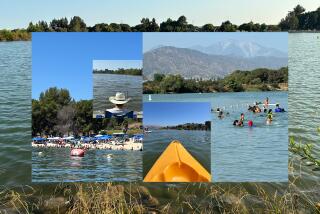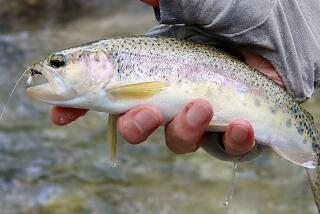Stripers Find the Rainbow’s End at Pyramid
- Share via
More than 25 anglers crowded together on a pile of rocks that jutted out into the water alongside the Pyramid Lake boat ramp. They were bundled up against 45-degree temperatures and dark, ominous-looking clouds. Some 300 yards out on the lake, a dozen boats had gathered, adding another 24 fisherman to the scene. Although all had fishing rods poised, no one was fishing. They were waiting.
“Here comes the truck,” came a cry from one of the shore-bound fishermen.
Instantly, the scene came to life. Men ran and jumped and yelled and settled into their positions, each claiming a large rock upon which to stand and cast. On the lake, the outboard motors coughed to life and the boats began circling just outside the inlet. All eyes were glued to the boat ramp. Descending the concrete incline was a truck pulling a trailer. On the trailer were two large tanks. And in the tanks were lively rainbow trout, fresh from more than a year in a hatchery and about to be turned loose for the first time.
This scene is a common one at many Southern California lakes: Fishermen waiting for the hatchery truck to provide them with thousands of trout and, so they think, to provide them with sport. The dim-witted hatchery trout are dumped into the lake, the fishermen fish them out in a matter of hours with such beguiling baits as cheese balls and marshmallows and everyone goes home to brag about outwitting the wily rainbow trout.
But this scene at Pyramid Lake, located one hour north of the San Fernando Valley, was different.
The anglers who had gathered in the early morning hours on Thursday had no interest in catching trout. As they watched the truck’s tanks belch their loads of water and fish into the edge of the lake, their eyes wandered out onto the lake, focusing on an area about 40 yards from where thousands of brilliant rainbows thrashed and began dispersing into the dark water.
In less than 30 seconds, the reason for their strange behavior became obvious. It became obvious the moment that a giant swirl of foaming white water appeared, followed by frantically jumping trout and then by the lightning flick of a gigantic black and silver form as it broke free from the water and dove back into the school of trout.
Only then did the men lining the shore and standing in their boats begin to cast their lures, six- and eight-inch plastic replicas of rainbow trout. The lures rained down on the water from all directions, sending up sprays of water of their own to go along with the natural splashes--the splashes of monstrous 20- and 30-pound striped bass beginning a murderous attack on the panic-stricken trout.
Striped bass, or stripers, are not native to Pyramid Lake. They are, in fact, not native to any lake. Until the early 1900s, their only natural home was the Atlantic Ocean, where they migrated with the warm currents from their spawning grounds in the Chesapeake Bay of Delaware northward to the waters off New England. In that natural environment, the powerful striper became king of the sport fish, growing to arm-wearying weights of 50 and 60 pounds and more. The record striper, caught off the sand dune coast of Cape Cod in Massachusetts, is more than 70 pounds.
Around 1920, the fish was brought West, riding in aerated, water-filled tanks aboard trains and other vehicles and eventually introduced into the Pacific Ocean in San Francisco Bay. There, the fish has thrived, becoming one of the premier targets for both commercial and sport fishermen. It eventually migrated from the bay area into the Sacramento River, swimming far upstream and returning to the ocean each year.
It was later introduced into the Colorado River and when biologists learned that the striper survived and prospered in a fresh water environment, they began planting small stripers in lakes.
In 1983, the California Department of Fish and Game dumped about 10,000 fingerling stripers into Pyramid. But they weren’t the first striped bass to prowl the deep lake. In 1974, when the 400-foot high dam was completed and what would become Los Angeles’ drinking water was sucked from the Sacramento River and San Joaquin Delta area through the state’s aqueduct system, thousands of striper eggs and fingerlings were also sucked in through the giant pumps. Eggs and some of the young fish survived the long, tumbling journey and were pumped out into Pyramid Lake.
Those fish, whose lives began hundreds of miles away, are now the giants of Pyramid Lake, the ones that feed voraciously every six hours, gorging themselves on other fish. Often, that food is shad, a small minnow-like fish that also thrives in the lake. But at other times, the marauding stripers gather ‘round the table, tuck bibs under their chins and stuff themselves with their favorite delicacy, fresh rainbow trout.
“The striper is the top of the line predator,” said Dave Drake of the Dept. of Fish and Game. “It will devour anything that swims, and trout are real visible and appealing to them. Stripers congregate where the trout are planted and, basically, eat them. Pyramid is still a popular lake for trout fishermen, but there are concerns on our part about planting trout and knowing that maybe 50 or 60% of them are being gobbled up by stripers right away.”
Trout, you see, are what make the Dept. of Fish and Game tick. Millions of California anglers buy licenses each year for the right to go fishing, and the vast majority of those people buy the licenses to catch trout, which can be fooled relatively easily and, as the stripers can attest to, taste great.
Stripers are not easily caught. Even during an all-out feeding frenzy, they are extremely wary of inhaling anything man-made. During Thursday’s five-hour attack that involved hundreds of stripers and about 50 anglers, only five or six fish were caught. Given those odds, most anglers would rather break out the cheese balls and fill their stringer with trout than flail in futility at the water all day.
But for the few who have been around at the stripers’ dinner time, experienced the crushing attack of the fish on a lure and felt the powerful surges, there is no cure.
“There was a morning in the middle of October, a Saturday morning, that was just incredible,” said Brett Bannerman, who began fishing seriously for stripers this spring. “It was real early and we were just motoring out of the marina. We weren’t paying attention to the water, just tying on lures and getting ready. The water was choppy, and up ahead of us we could see the whole shoreline kind of alive, with splashing all over the place. This section of choppy water was about 200 yards long, and at first we thought it was just the wind against the shore. But then we saw the stripers.
“When we got up to it, there were hundreds of 12-inch trout flopping around on the shore, coming right out of the water to get away from the stripers and beaching themselves. It went on like that for about four minutes, and we didn’t get a fish. We were trying to tie our lures on and our hands were shaking so bad we couldn’t do it. I was so excited my hands wouldn’t do what my brain was telling them to do.”
Bannerman said he encountered three more similar feeding frenzies in the next few hours, but despite being prepared for them and launching long casts into the middle of the frays, he and his partner came up empty.
Others have had more success, and some anglers have had an incredible number of battles with the striper. Perhaps the most successful was Raymond “Hump” Wall, who is now 73 and fishes very seldom. But Wall estimates he has hauled nearly 700 stripers from Pyramid over a seven-year period. And he held the lake record with a bucket-mouthed giant of 35 1/2 pounds until April 8 of this year, when Butch Augustine whipped a 38-pounder.
Wall had a slight advantage over most anglers. He worked at the lake’s concession stand for those seven years and got to get in an hour or so of fishing before the lake opened to the public. Because a striper feeds with less caution under the cover of darkness and the dim light of sunrise, the hour that Wall had to himself each day was valuable.
“Every time that trout truck would pull up, boy those stripers just went crazy,” Wall said. “They were right there, waiting for that truck. It was like those fish had damn calendars or wristwatches. And boy, did they love them trout. I caught one striper, a big one, maybe 28 pounds, and it had five trout inside its belly. Five of ‘em. And he wasn’t full yet, because he chased my lure and wanted to eat that, too.”
The stocked trout will stay around the boat launching ramp for a day or two, trying to shelter themselves from the stripers and at the same time get acclimated to the cold water of the lake, which has an average depth of 200 feet with a few holes as deep as 355 feet. Those that survive the first few days eventually scatter throughout the 1,297-acre lake. But they are never quite far enough from the stripers.
“We’ve followed the stripers all the way down to the dam, and they were still chasing those trout,” said angler John Lowry. “No matter where the trout swim, the stripers are always after them.”
More to Read
Sign up for The Wild
We’ll help you find the best places to hike, bike and run, as well as the perfect silent spots for meditation and yoga.
You may occasionally receive promotional content from the Los Angeles Times.






